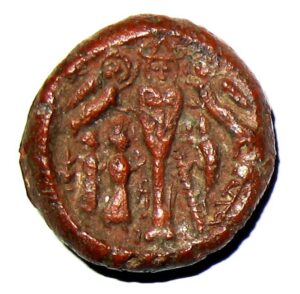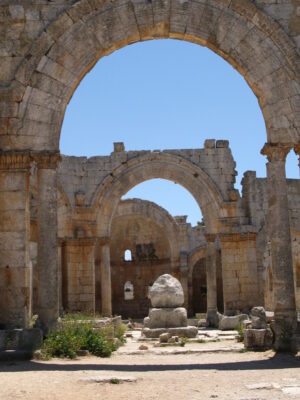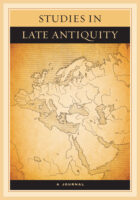Saints and Stylites: A Q&A with Dina Boero

Congratulations to Dina Boero, whose article, "The Space of the Stylite: Columns and Their Topographical Contexts," published in Studies in Late Antiquity, was awarded the 2025 Hagiography Society Article Prize. We recently talked with Dina over email asking her about the award and her research. We invite you to read the interview below and to click through to her article, which we have made free to read online for a limited time.
What is the Hagiography Society and why did they award your SLA article their prize?
The Hagiography Society is a professional society, founded in 1990, that promotes communication among scholars and students whose research involves the study of holy men and women—people whom we often refer to as “saints.” One challenging but also exciting component of studying saints is the need to work with different primary sources, for example, biographies, artistic representations, hymns, shrines, liturgical rituals, and devotional objects. These sources require scholars to move between the disciplines of Religious Studies, History, Literature, Archaeology, and Art History. The Hagiography Society helps foster those conversations. Originally, the society focused on medieval Christian saints, but it has expanded to incorporate the study of holy people and the forms of devotion to them across historical periods, geographic regions, cultures, and religious traditions. One important feature of my article is its multifaceted use of material evidence in understanding a saint’s choices during his life and the appropriations of his spiritual capacities after his death. I show not only how a saint’s abode-turned-pilgrimage site changed over time, but also how it did so in conversation with a landscape teeming with religious meaning, both Christian and non-Christian. As the prize committee wrote, “Boero shows us how drawing on many and varied ways to think about saints and sanctity creates a richer, more textured understanding of both these saints and the landscape they constructed.”
Who exactly are the “stylites” and what does your study of them in Syria during Late Antiquity tell us about saints and early Christianity that we didn’t know before?

“Stylites” are Christian saints who lived for years and even decades on top of columns. While late antique and medieval authors give many explanations for the significance of this particular devotional act, all generally agree that the column created a powerful vector between heaven and earth, and placed the stylite on high, as if living among angels. The pilgrimage token in figure 1 offers a great example of this. The column is located at the center of the image. At the base of the column, supplicants approach the column with their arms raised in prayer. One even climbs a ladder attached to the column. At the top of the column, angels crown a stylite named Symeon, who is pictured in the token and is the focus of this article. Symeon was the first of at least 117 stylites who lived between the fifth and the eleventh centuries in the eastern Mediterranean world. While some stylites did set up their columns in cities, the vast majority lived in rural contexts. Their columns towered over villages, hilltops, roads, and sometimes the ruins of Greco-Roman temples. Accordingly, stylites have much to tell us about the workings of rural religion in the eastern Roman empire, the Byzantine empire, and the medieval Middle East. They bring to the fore saints’ involvement in forming tight bonds between different actors in rural society, the management of large groups in times of crisis, and the social regulation necessary for maintaining agricultural productivity in a world characterized by scarcity. They also tell us a great deal about religious change, first from traditional Greco-Roman religion to Christianity and later from Christianity to Islam. Although stylites and their columns may look to be dramatic statements of the intercessory power of Christian holy persons, they also bring to light the continuity of embodied religious practices in rural communities of the first millennium CE.
What is it about SLA that made you seek out the journal as an ideal venue for your scholarship in general and for this article in particular?

In my mind, Studies in Late Antiquity is publishing the most cutting-edge scholarship in the field. Its geographical and methodological breadth gives it a richness that most journals do not have. As editors, Tina Sessa and Ra‘anan Boustan have a done phenomenal job shepherding top-notch work by young scholars, which makes Studies in Late Antiquity especially exciting. But honestly, the real clincher for me in selecting Studies in Late Antiquity as a publication venue was the unlimited color photos. Most journals don’t include such stunning images. Color photos are essential for communicating to the reader the multi-religious visual environment in which Symeon acted, how clerics and devotees adapted Symeon’s shrine to create a potent locus of liturgical worship, and how monks repurposed Symeon’s practice of column-standing to assert a powerful Christian presence in the landscape. For example, in figure two, you can see the base and lower section of Symeon’s column. Behind the column is the eastern arm of the cruciform church, where liturgical celebrations took place and the altar was located. Together, column and altar linked veneration of the column to ecclesiastical ritual. Finally, there is the issue of memory and preservation. Symeon’s pilgrimage site survived in an impressive state of repair into the early twenty-first century, while the region in which his shrine is situated preserves the remains of over 700 villages. However, the site suffered irreparable damage in the recent Syrian Civil War, making photographic documentation of the state of the site before the war all the more important. During airstrikes in 2016, in fact, a missile landed right next to the base of Symeon’s column. The lower section of the column was blown off of the base. The base itself cracked and was later removed from its foundations. Given this and other damage at the site, photographic evidence is and will be critical for ongoing historical, art historical, and archaeological analysis.

We invite you to read Dina Boero's article, "The Space of the Stylite: Columns and Their Topographical Contexts," for free online for a limited time.
Print copies of the Summer 2024 issue of Studies in Late Antiquity (issue 8.2), in which the article appears, as well as other individual issues of SLA, can be purchased on the journal’s site.
For ongoing access to LALVC, please ask your librarian to subscribe and/or purchase an individual subscription. ALAA members are eligible for a discounted price on LALVC subscriptions.
